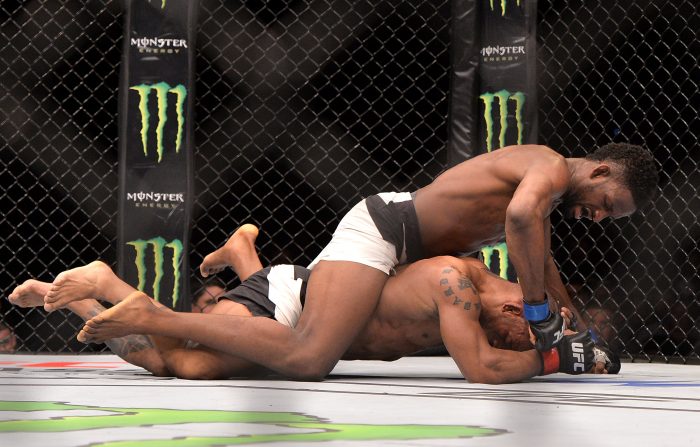What’s the difference between MMA and the UFC? Are there any actual rules? If you’ve ever found yourself asking these questions then you should really read on.
As the popularity of mixed martial arts (MMA) continues to grow apace, new fans are being attracted all the time. While MMA (in particular the UFC) has moved on dramatically from its early days of mis-matches and freakshow elements to become a legitimate, widely respected and hugely popular sport not everybody fully understands what it’s all about.
With that in mind here’s a quick guide to all the questions most commonly asked about MMA.
1) Just what IS mixed martial arts?
Mixed Martial Arts is the fastest growing sport in the world. MMA encompasses disciplines from various martial arts and Olympic sports, such as boxing, kick-boxing, karate, jiu-jitsu, muay thai, tae kwon do, wrestling and judo.
Rounds are five minutes in length and there are typically three rounds in a contest, unless it’s a championship fight (or a non-title UFC main event), in which case, the contest lasts five rounds.
2) Mixed martial arts is the sport NOT the UFC
Mixed Martial Arts is the name of the sport. The Ultimate Fighting Championship (UFC) is the name of the premier organisation. Akin to basketball being the sport, but the NBA being the name most people associate with it.
The UFC has been the driving force behind the sports popularity and they have done a great job of marketing their brand. However, we’ve all heard casual fans tell their friends that they ‘train UFC’, so next time you hear that, politely correct them.
3) Yes, there ARE rules. Many rules…
A common misconception is that MMA has no rules, when in fact, it has many. The Unified Rules of Mixed Martial Arts is the most common rule set used throughout the world. All state athletic commissions in the United States adopt the Unified Rules to help regulate the sport.
The rules are thorough and include the size of the fighting area, specifications about hand wrapping and information on judging and fouls, among many other things. They are an essential read for those wanting to understand the sport.
4) There are fouls too
In the Unified Rules, there more than 25 fouls officially listed. Some examples are; no head butting, no small joint manipulation and no unsportsmanlike conduct that causes an injury to an opponent.
If a foul is determined by the referee as intentional and flagrant, he can disqualify the competitor. Typically, a foul will result in a point being deducted, which could be crucial in a three round fight. A fouled fighter has up to five minutes to recuperate.
5) MMA DOES have weight classes
The current weight classes in the UFC are:
Flyweight up to 125 lbs
Bantamweight over 125 to 135 lbs
Featherweight over 135 to 145 lbs
Lightweight over 145 to 155 lbs
Welterweight over 155 to 170 lbs
Middleweight over 170 to 185 lbs
Light Heavyweight over 185 to 205 lbs
Heavyweight over 205 to 265 lbs
6) How is a fight scored?
There are three judges sat cage side, each with a different viewpoint of the contest. They evaluate MMA techniques, such as effective striking, effective grappling, control of the fighting area, effective aggressiveness and defense.
They use the 10-Point Must System, the winner of the round gets 10 points, the loser gets 9 or less, unless, in rare occurrences, it’s an even 10-10 round.
7) The cage is actually for the safety of the athletes
The term ‘cage fighting’ is detestable, but the cage (referred to as ‘The Octagon’ in the UFC) is an essential part of fighter safety. In the Australian state of Victoria, MMA events that use a cage are banned, when in fact, the cage is used to protect the athletes, particularly when the wrestling aspect of the sport is involved.
The Unified rules of MMA state, ‘The fighting canvas area shall be enclosed by a fence made of such material as will not allow a fighter to fall out or break through it onto the floor or spectators’.
8) MMA fighters are highly skilled sportsmen and women
MMA fighters are some of the most well conditioned and skilled athletes in sport. It takes years of dedication and hard training to be successful. Many MMA fighters in the UFC have University degrees, as a direct result of their wrestling scholarships.
In the UK, you’d be hard pressed to find sportsmen and women more articulate and approachable. The first female UFC fighter from the UK, Rosi Sexton was even a Cambridge graduate!
9) The UFC is the biggest organisation but it’s NOT the only one
UFC programming is broadcast in over 145 countries, to nearly 800 million TV households worldwide, in 28 different languages. The UFC is also the largest pay-per-view event provider in the world. Yes, it’s huge.
However, there are other organisations. In America, Bellator Fighting Championship averages over 600,000 viewers for their fight cards. The standout organisation on our shores is unquestionably, Cage Warriors. A respected organisation, Cage Warriors has been the starting point for many current and former UFC fighters.
10) A fight can finish a number of different ways
The ways in which a bout can end are as follows: submission, technical knockout, knockout, judges decision, forfeit, technical draw or decision and no contest.
At the time of the UFC’s 20th Anniversary in November 2013, there had been 833 knockouts, 644 Submissions, 964 Decisions and 34 Other results in the UFC.
11) Handshakes and hugs are important (really)
There is a unique and unparalleled respect in MMA. Fighters have even been known to talk and joke with each other before they weigh in and face off.
There is an entertainment aspect to the sport, but at the end of many bouts, the fighters will shake hands and embrace in the Octagon and then again backstage. They respect their opponent and they respect the sport.









